On February 28, the breakup of Antarctica's Wilkins ice shelf into the ocean, which measured 406 square kilometers, made headlines around the world.
This alarming discovering was made by Dr. Ted Scambos from satellite images. Dr. Scambos is the senior research scientist at the National Snow and Ice Data Center (NSIDC) at the University of Colorado in the United States.
Dr. Mark Serreze is also a senior research scientist at NSIDC and a Cooperative Institute for Research in Environmental Sciences (CIRES) fellow. He is a member of the American Geophysical Union and the American Meteorological Society.
Dr. Serreze has published numerous reports on his findings of the Arctic's shrinking sea ice cover.
Currently, he is evaluating the causes for the decline in Arctic sea ice.
On today's Planet Earth: Our Loving Home, Drs. Scambos and Serreze, share their expertise in an interview with Supreme Master Television.
Let's now hear from Dr. Serreze on his research in the area of glaciology, polar science and what the implications of their discoveries of Arctic sea ice melt mean in terms of climate change.
Supreme Master TV: My first question is why the Arctic Sea ice is so important to keep the ecological balance of the earth?
 Dr. Serreze:
Dr. Serreze: we think of
the Arctic, we can think of it as
the refrigerator of the Northern Hemisphere climate system. Now, of course, part of that refrigerator is just located far to the North so that the sun's rays don't strike as directly as they would in the Equatorial regions. But another big part of this is the existence of that sea ice cover itself.
It is reflective so most of the sun's energy that hits that surface is bounced right back up into space again, and keeps the Arctic cool. But now we are warming the system up, and what we are starting to do is lose that sea ice, that reflective sea ice.
We are changing the nature of that Arctic refrigerator. The thing is, is that everything in the climate system is coupled together. Eventually what happens in the Arctic influences what happens down here; I am talking say at middle latitudes like of the Unites States.
Supreme Master TV: When you think of losing ice in the Arctic, what's the biggest impact?
Dr. Serreze: When we think of losing Arctic ice, we can think of two components of the ice. One of them would be that ice which is locked up in the ice sheet, and we are talking here about Greenland.
Now when we start to melt down Greenland, that has an impact on the sea level and there's strong evidence that that is in fact happening right now.The other component of what we call the aqueous sphere in the Arctic, is the sea ice.
Supreme Master TV: I see.
Dr. Serreze: Now the melting of the sea ice, loss of the sea ice itself does not have an effect on the sea level. Because that ice was already floating, it's very different than Greenland. However, what we are talking about is loss of a very large area of a very white surface, this white surface.
Albedo is the reflectivity of a surface. Snow and ice if you could see it has high albedo, [and when] we lose that sea ice cover, we reduce that Albedo, we make that surface darker, [so it] absorbs more of the sun's energy, the Arctic heats up.
But everything is connected, so if we change the Arctic sea ice cover, we change these patterns of heating, the atmospheric circulation responds to changes in heating.
So the argument is, you lose that sea ice cover you start to impact things like patterns of weather, patterns of participation outside of the Arctic.
We think of the Arctic sometimes as this faraway place, what happens there doesn't matter, but we are starting to learn is that it indeed does matter.
Supreme Master TV: This is why they talk about feedback and that type of thing where it just goes in a circle, like a downward spiral.
Dr. Serreze: Exactly, this is the whole concept of feedback. Even our earliest climate models of circulations have been telling us that as we start to increase greenhouse gas concentrations it's in the Arctic where we are going to see the changes first and it's in the Arctic
where those changes are going to be doubly pronounced, and a large part of that sensitivity is due to these feedback processes.
The idea is that once you hit the system with something, the effect of it starts to snowball, and the most important feedback in the Arctic is associated with this change in albedo, especially associated with this ice cover.
We warm up the climate a little bit by putting atmospheric greenhouse gases in it, we melt some of this highly reflective snow and ice cover, that means more of the sun's energy is absorbed, the Arctic becomes warmer as a result, that means more of the snow and ice cover melts, the Arctic becomes even warmer so it's a feedback that we call it, a process that feeds on itself.
HOST: Dr. Ted Scambos specializes in studying the glaciers of Antarctica. He was first to discover the collapse of the Wilkins ice shelf in Antarctica via satellite images and lead a team of international scientists to study the region.
Dr. Scambos was a contributor of the report, Climate Change 2007: The Physical Science Basis for the UN's Nobel Peace Prize winning Intergovernmental Panel on Climate Change (IPCC).
He shares his knowledge on the significant role of ice in the polar regions here on Supreme Master elevision
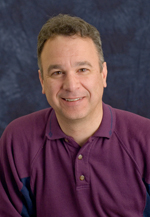 Dr. Scambos:
Dr. Scambos: The only other component that's slightly different is the
ozone hole in Antarctica, which is also caused by human activity, but the main event in 2002, I think, really was a turning point. It's an iconic image for saying that the Earth is changing because of warming; the blue patch of ice crumbling away, streaming across the ocean.
That's become an iconic image; it's been used hundreds of times by newspapers,books, magazine articles.
Supreme Master TV: There have been broke up of ice shelves that are much larger than that, still, in the past, in 1955 or something, I thought.
Dr. Scambos: In 1955, there was an iceberg that was sighted that was supposedly larger than the largest iceberg that's been mapped today.
I've looked at that newspaper story and I've looked at some of the ice shelves. That's normal, and Antarctica's been behaving that way for millions of years.
What's not normal is to see melt ponds on the surface, no sea ice in front of the ice shelf edge, and a sudden break-up, not just in one big piece, but crumbling down, disintegrating, absolutely blowing itself up within just a few weeks. The other thing is that the ice shelf doesn't recover from it.
There's no re-growth; there's no new shelf that starts to push out in the aftermath of one of these events.
HOST: The dramatic changes in the Arctic sea ice melts is a definite sign of the acceleration of global warming. Dr. Ted Scambos will further explain on other changes found in ice shelves of the polar regions when Planet Earth: Our Loving Home returns.Please stay tuned to Supreme Master Television.
Dr. Ted Scambos, senior research scientist at the University of Colorado's National Snow and Ice Data Center and the lead scientist who discovered the recent collapse of the Wilkins ice shelf speaks with Supreme Master Television.
Supreme Master TV: Do you see any immediate threat to the ice shelf now that you look at it?
Larsen A ice shelf fell off, right? And Larsen B already fell off recently, right? Are we watching C?
Dr. Scambos: Yes, there is a C, and there are plans to visit it as part of the International Polar Year.
There're two major efforts, one from Great Britain and a joint effort between Chile and the U.S. to visit Larsen C and set up measurements so that we know what it was like before it really began to retreat due to global warming. We thought that the only way that you would lose an ice shelf is part of global warming, but the only way you lose it is through this very slow process of calving and surface melting.
You have to wait for the warmth to reach the point where from the bottom of melting by the ocean and from the top of melting by the air, that both of those things to conspire to thin the ice shelf to zero.
But we didn't anticipate that there was this runaway process of fracturing that happens once you get the top soaked with water, the water actually acts to blow the ice shelf apart. Not by frost heat , this is something people in the north are familiar with, rocks can be split open by a film of water that gets into the crack.
It's not quite the same process. (Okay.)
If you get a tall column of water there's quite a bit of pressure at the bottom. And since ice is less dense than water or ice floats on water, the ice doesn't have the same level of pressure;
it's not as dense. So, at a bottom of a crevasse, it begins to fill with water because there's no water on the surface. At the bottom of that crevasse, you get to a point where the pressure is so high that just the weight of the heavy water inside the lighter ice is enough to crack through the ice and drive it all the way to the bottom. It was something that had been talked about for some glaciers but had never been - nobody had ever thought that it could happen on such a large scale so suddenly on an ice shelf. Right now, that's still the best model.
There were some other things;
people have talked about how the oceans are getting warmer, thinning the ice from underneath, how the ice shelf, because it was thinning, was starting to lose contact with coastline, starting to break away from the coast.
But in terms of what happened in March of 2002 and earlier in 1995 for the Larsen A, that had to do with water fracture in the ice very suddenly one hot summer. So, if we got one really hot summer between now and 2020, we could see the Larsen C do the very same thing.
Dr. Scambos: What we've seen is that ice shelves are good indicators of climate change because they respond not only to air temperature on the surface, where the rest of the ice sheet responds too, but also to warming in the ocean underneath. That starts to trim them underneath, so they respond very quickly. The bad news is that these ice shelves are all fed by these glaciers coming off of the large ice sheet.
When you break the ice shelf away, take that away, all of those glaciers accelerate very rapidly, flowing into the ocean, calving very rapidly and dumping ice that was on the continent out on the ocean.
This is another case where glaciologists were surprised beyond their wildest imagination as to how fast the system could respond. We went from four glaciers that fed the Larsen B that were flowing at about a rate of one meter per day, to feeding it at six to eight meters per day, within the space of one year, a year and a half, after the loss of the Larsen B ice shelf.
If that happens elsewhere in Antarctica where there are even larger glaciers, we'll see very sudden jumps in the rate of sea level rise.
Dr. Scambos: It's clear that ocean warming along the southern Greenland coast and also on the western side of Greenland, the part that's close to Canada, glaciers are responding very rapidly; they respond in particular to surface melting and to warmer oceans.
The trigger that appears in Greenland appears to be a warmer ocean, and then melting on the surface appears to accelerate the flow into the ocean, from things that were triggered by a warmer ocean.
In Antarctica right now, in the peninsula, it seems as though air temperature is leading the way,
but elsewhere in Antarctica, ocean temperature's creeping up at depth, because the surface water in Antarctica and the surface ice in Antarctica is still quite cold. But underneath that cold layer, warm water from elsewhere in the world, from the temperate parts of the world is seeping in, and if there's a very deep layer of ice that's touching the ocean, it's being melted away and breaking up and accelerating, even though Antarctica is remaining quite cool so far.
So, in the poles, anybody who works in polar science, nobody questions whether or not we're in trouble, a warming world, because we see it in our field areas every year.
Dr. Scambos: Right now [in] 2008, we’re just emerging from what would be considered “noise” in the climate system, a hot spell and a cold spell Consistently we’ve been near the warmest temperatures we’ve ever heard of, ever seen, ever recorded for the last ten or fifteen years have been the warmest years of any of the last 150.
Again and again and again we are getting close to that record. We are now emerging from anything that resembles “noise” in the climate system to truly seeing global impacts and permanently warmer climate conditions.
SUPREME MASTER TV (e):
Do you think in the last five or six years you’ve become more and more convinced that it’s definitely global warming and that it couldn’t be anything else?
Guest (e):
I was pretty convinced in the late 1990’s. I think the results from two very important and very famous ice cores from Greenland provided convincing evidence that this period in time the atmosphere was far different from any atmosphere the Earth had had in the past 100,000 years. That warming trend that we had seen in Arctic had taken off starting in about 1975.
Guest (e):
And I just want to underscore that nobody, nobody debates whether or not greenhouse gases can warm a planet. We know that’s how planets work. We know that’s how Venus works. It’s red hot on its surface because of greenhouse gases. That’s why Mars goes through climate change because its atmosphere is almost all greenhouse gases, it’s almost all carbon dioxide And we know that warm and cold periods on the earth have been amplified by what happens to the atmosphere whether or not carbon dioxide increases or decreases or methane increases or decreases in the atmosphere.
Nobody who is in the academic world on either side of the debate disputes those ideas. The only question has been: Could 2 watts per square meter actually change climate the way we’ve seen it change so far and would an additional 200 ppm of carbon dioxide, for example, would that change climate by 5oC or 4oC, whatever the projection is for the end of the century.
Dr. Scambos: There are many, many feedbacks in the system. The Earth turns out to be in a balance that’s actually fairly precarious and small pushes in one direction, particularly in the polar regions, lead to very large changes in the snow and ice cover of the world.
And that in turn amplifies the warming. Once you push an area like the Arctic Ocean towards retreat then you start to warm up the Arctic Ocean. That heat is retained through the winter. It is very difficult for the ice to grow very thick and therefore it’s easy to melt it again the next summer and you get into this feedback loop.
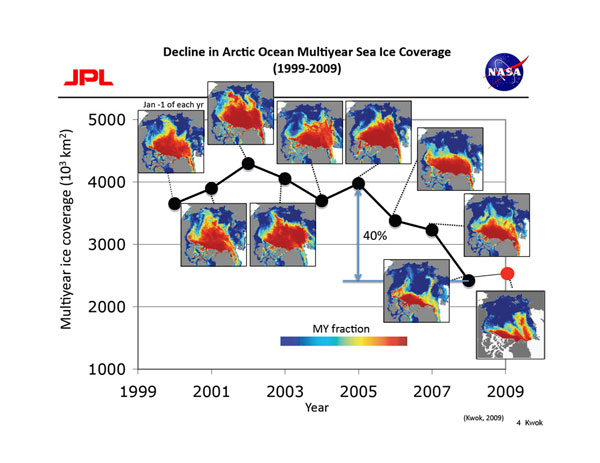 (Image Credit - nasa.gov )
(Image Credit - nasa.gov )
Now the good news is that if we ever do manage greenhouse gases in the atmosphere and we turn this around and start to cool the planet or stabilize the planet at some climate, the reverse feedbacks also work fairly quickly.
If you have a cool ocean, if you have a cool atmosphere, the snow and ice can survive through the summer. Then you’ll again begin to rebuild the Arctic ice cap. It’ll take a little bit longer for things like ice sheets to respond.
SUPREME MASTER TV:
I’ve read different articles about millions of years ago where the continent was arranged differently and we didn’t even have polar ice caps at some point and there was a period of warming up and cooling down due to solar variation or orbiting. Why is it so urgent now that the global warming issue or this greenhouse gas has become such a big factor?
Dr. Serreze: We certainly know that the Earth climate has very strongly changed over many different time scales. Take for example the ice ages of the past, look at the past two million years.
We know what caused those, so if we’re associated with changes in the Earth's orbit relative to the sun, these are called “Malenkovic forcing.” What these did was alter the amount of solar energy you got or, received at different parts of the earth's surface over different parts of the year And it turns out you can get these forcings in just the right situation, which gives you an ice age. Change those and we go to what we call an inter-glacial. But what’s happening now is that we are having a different climate forcing. Our climate forcing is clearly due to human activities by increasing the concentrations of greenhouse gases.
Climate doesn’t change just by magic; we sometimes hear, “Oh, climate has varied in the past. Why is today any different?” You’ve got to remember past climate changes, just like those of today, have to be identified with a climate forcing. We know what that climate forcing is today; we know that climate forcing is due to our activities.
SUPREME MASTER TV:
So from like 1750, the industrial age, we started seeing these changes and more human impact than just by nature, (Exactly.)
Dr. Serreze: That by itself, the carbon cycle, is what we call an equilibrium. There’s atmospheric carbon dioxide taken down from the atmosphere by the oceans; the oceans release some of it back up into the atmosphere. There’s an exchange of atmospheric carbon dioxide between the land surface.
But things have equilibrium, but what we’ve done now with fossil-fuel burning is taking carbon that was in long-term stores locked up in the ground millions of years and putting it into the atmosphere. So we are changing that balance and we know that carbon dioxide like some of the gases, is a greenhouse gas. The climate must warm in response. The physics is inescapable.
SUPREME MASTER TV:
You know, I read something on here also that they say that even if the greenhouse gas level stays the same right now, the ocean temperature continues to rise because it’s such a large mass that it can continue to do that.
Dr. Serreze: Well, what you are talking about is what we call “the heat is still in the pipeline,” heat in a pipeline. The issue here is we talked about these climate forcings. We have a forcing in the climate and then the climate system warms up. But there is a lag effect to this, so even if we stop greenhouse gas emissions now, there is still this heat in the pipeline; the key however is to try and keep this warming to a slow crawl.
No matter what we do today, there is still this further heating in store. But the key is can we keep that further heating down to a low enough level that we can manage it.
SUPREME MASTER TV:
I see.
Dr. Serreze: If we let it get to a dangerous level, then we have problems, then we start to see for example, massive melt down of Greenland and Antarctica starting to participate in that, a pattern of warming that starts to strongly influence things like patterns of agriculture for example.
But we have to start acting soon. So we are going to have to live with some warming but if we can keep that slow enough, that warming slow enough, we can adapt to it, we can bring on new technologies to reduce the size of the problem.
HOST:
Through the years, scientists have meticulously measured the differences in sea level rise and its effects on the ecology and coastal residents. Dr. Ted Scambos further explains the effects with a greater sea level rise due to climate change.
Dr. Scambos: 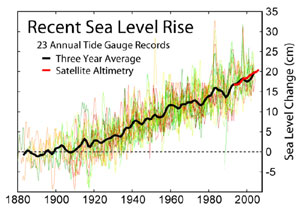
For 400 years, we had a sea level rise of about one-and-a-half millimeters per year, and that is not much. But in the last 15 years, the 1990s, we had a satellite that could make a measurement of how fast
sea level rises. Now, it’s about
three millimeters per year, and the most recent data is that it’s about four millimeters per year.
But when it starts to be a centimeter per year, a few centimeters per year, then in a very short period of time, you realize that you’re going to have to rebuild your port infrastructure, dike infrastructure. You’re going to lose the real estate that you have in precarious places around the coastline of the world
It gets to be a serious concern, we’re going to recognize that we have a real problem with sea-level rise. I think the bigger threats right now are hurricanes, tornados and drought because of climate change because of the impacts we’re having on the ocean and the air circulation. Those are the more direct ones that I see happening
Dr. Ted Scambos: 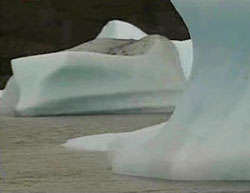
The Arctic Ocean is covered with sea ice; that is, the ice cap in the north, a very thin, thin plate separating the ocean from the atmosphere, only about a meter or two thick, only about three-, six-, nine-feet thick.
In the Antarctic, there is a huge ice mass over the continent that’s centered on the South Pole. So they’re almost like opposites. The Antarctic has a very tall, like the Tibetan plateau almost, a very tall mass of ice centered around the Pole, but it is surrounded by sea ice most of the year, a fringe of the sea ice that comes and goes almost completely every year.
Ice shelves are plates of ice that have flowed from that thick continental ice that’s on the continent, flowed out across the ocean. And because they were thick and because the ocean was cold, they survived as a solid plate advancing out across the ocean and usually they flow out until they encounter these little islands or peninsulas or whatever to stabilize them.
VOICE: Dr. Scambos along with other climate experts have stressed the importance of acting sooner rather than later to reverse the effects of global warming.
Dr. Scambos: Right now, what we’ve seen is a certain amount of pulsing. You remove a little bit of ice from the front, and there’s this race, the glacier tries to accelerate. The response of the ice is to accelerate and try to re-stabilize against those rocks. And then if the water is warm enough, it keeps cracking it off so that even though it’s flowing faster, it can’t reach those rocks before it breaks off and you lose some ice off of the ice sheet.
But then, if it does re-stabilize against those rocks, then that quickly backs up the ice here and you begin to re-accumulate the ice again onto the ice sheet. But that mass of ice that was lost is now in the ocean, and it takes a long time for that to be put back as snow, centuries, millennia to put it all back.
So, if we get lots of these glaciers suddenly on a run-away and the ocean is a lot warmer so that the glacier is continually on this treadmill trying to keep up, pushing ice out in front of it, but continuing to sort of withdraw more ice from behind to feed this faster flow, we’re going to see a situation that can’t be slowed down very fast, can’t be turned around very fast and so we’ll have to plan.
Boston Harbor, got to rebuild it every 50 years because sea level rises by two meters every year.
The Mississippi Delta, all that land down there, all the infrastructure down there, we probably can’t trust that that will be there in another 50 years because it’s going to be flooded faster than we can, even with a more aggressive plan for things like levees, we can’t keep up.
Climatic refugees I think are a big potential problem from places like Bangladesh, from places that are hit by drought or are no longer arable. Maybe it’s not a severe drought but agriculture doesn’t work as effectively as it used to.
There are many, many people in Southeast Asia, in China, in India. A lot of the world's net productivity in those areas is being used to feed the people that live there. If that were to decline because of climate change, we would have a huge problem on our hands.
SUPREME MASTER TV(m): They say, “If you lose all the ice in the Arctic the sea will rise by 20 feet. But if you lose all the ice in Antarctica the sea will rise by 200 feet.”
Dr. Scambos: That’s what the potential is. And even though a tiny part of Antarctica is engaged right now in this faster flow and warming, it’s still having a significant contribution. Greenland is having a very significant contribution and of course warming of the oceans themselves is also starting to have a big effect. This is all about the sea-level rise part of the problem.
SUPREME MASTER TV(m): And it’s high above.
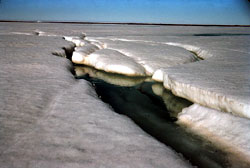
Dr. Mark Serreze: That’s right, and part of this is just that the Arctic is a warmer place. If we talk about these feedbacks that we were talking about, losing that sea ice from a melt, it’s predicated on a very, very important number, the freezing point of water, 32˚F, 0˚C, that critical number.
20 years ago, you’d have part of the year where most of the Arctic was at or above that critical point.
But we warmed up just a little bit, now all of a sudden you start to greatly extend the length of that melt season, so things can really get going.
So the Arctic has always been closer to that tipping point than the Antarctic because it’s closer to that critical number, that critical freezing point number.
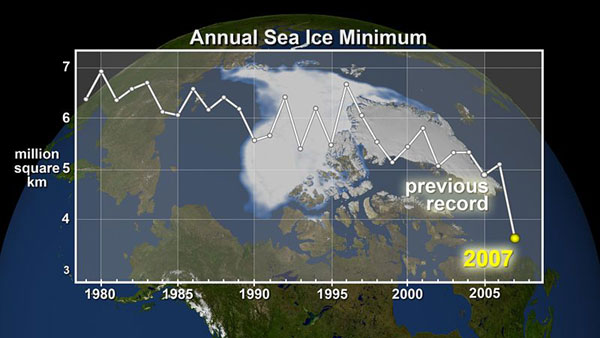 (Image Credit - nasa.gov )
(Image Credit - nasa.gov )
Dr. Scambos: We have to take the signs that we’re seeing in the polar regions. They’re plain as day. There’s no interpretation behind seeing that huge bite out of the Arctic Ocean’s ice cover last summer. That was phenomenal. Those events up there are telling us that big things are in store for us if we don’t start to change what we’ve done to the atmosphere.
Dr. Mark Serreze: Yeah, it’s not so much the change that we’ve seen now that is what is of concern, it’s what’s out there in the future.
Dr. Scambos: Right, what’s happened so far is just the warning shot.
Dr. Mark Serreze: It’s just the harbinger.
Dr. Scambos: The cherry blossoms in Washington are a lot earlier than they used to be and it seems that we don’t get quite as bitter a winter, except for this winter, as we used to have.
It seems like things green up faster, there are birds migrating that didn’t used to go to certain areas.
When that polar cap starts to shrink, we’re going to feel it because it’s basically the air conditioner; it’s the cold end of a system that’s driven by the sun, and the air actually circulates in a couple of big circulation patterns, but the thing that keeps the heat from running away with temperature is that there’s this cold area that radiates a lot of heat.
This space doesn’t absorb much energy because of this big white surface up in the Arctic Ocean.
If we lose that, even if we lose it for a few weeks during the summer, a huge amount of heat gets dumped into that ocean water, the ice doesn’t recover as well the next fall, we go through longer and longer periods with a dark area instead of a white area up in the North Pole and that feeds back into weather throughout the Northern Hemisphere.It’s going to feel as though there’s a sudden shift in the pace of global warming when we begin to lose Arctic ice.
SUPREME MASTER TV(m): There’s a scientist, Katey Walter. She was looking at the potential methane that’s coming out of either the permafrost or the deep ocean.
Dr. Scambos: Right now we are beginning to emerge from that warmer conditions. What we’re going to see if [things] keep going in this direction is that other sources of methane and CO2 are going to start to be triggered and released into the atmosphere.
And we won’t be able to control those even with the best technology in the world managing our own CO2 and methane emissions. I don’t want to think about what it would take to try and control gases coming out of Siberia and Canada.
I can imagine us sequestering CO2 from coal-fired plants, switching to different kinds of automotive transportation, figuring out a different way to power houses and businesses. Those things I can imagine. Stopping gas from coming out of the ground across the entire northern third of the world, I can’t imagine.
Dr. Scambos: If we allow climate warming to continue, we’re going to be faced with not just trying to solve the problems of the gases that are being emitted and reconstruct our infrastructure, but also the growing cost of the problems that are being created by climate change because of sea level rise, an increased number of hurricanes, problems with food, feeding people.
Dr. Scambos: But this thing turns around fast also if we control climate. The problem is that if we take the view of “We’re going to try to put the brakes on this, and it may take a whole century to do that,” the time scale for the earth recovering naturally is very long and we will be in for a lot of change in terms of how it impacts human lives for several centuries.
Unless we take the attitude that we really need an aggressive plan to address greenhouse gases, unless we take that attitude, we should be thinking about adaptation rather than mitigation.
There’s a problem in the discussion about greenhouse gases, especially to the public, because all of the forecasts tend to go to the year 2100 as if some magic time at which the events all come to a halt.
That’s not the case. There is no limit to how warm the world will get unless we set a limit.
It is paramount that people everywhere understand: Eventually it is up to us to stop this.



